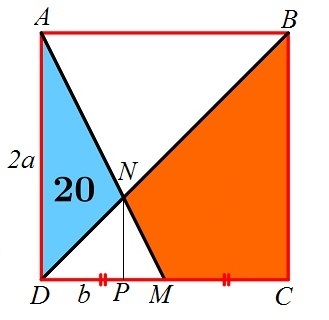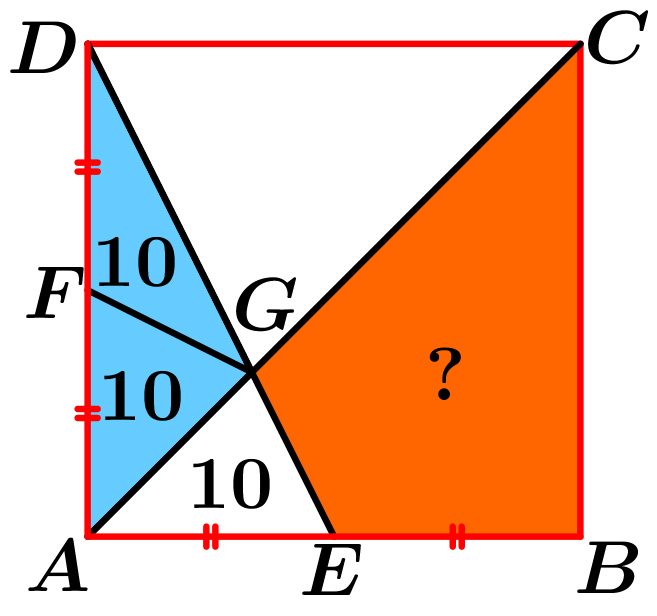Segments in square
In the square in the diagram, the diagonal intersects the line segment drawn between the upper left vertex and the midpoint of the base.
If the area of the blue triangle is 20, then what is the area of the orange quadrilateral?
The answer is 50.
This section requires Javascript.
You are seeing this because something didn't load right. We suggest you, (a) try
refreshing the page, (b) enabling javascript if it is disabled on your browser and,
finally, (c)
loading the
non-javascript version of this page
. We're sorry about the hassle.
3 solutions

Let the square be A B C D with sides 2 a . The midpoint of C D be M . The line A M cuts B D at N and the altitude from N meets C D at P and D P = b .
We note that △ A M D is similar to △ N M P . Therefore,
N P P M D P P M b a − b 2 a − 2 b ⟹ b = A D D M = 2 a a = 2 1 = b = 3 2 a Since ∠ B D C = 4 5 ∘ , ⟹ N P = D P
Then, the area of △ D M N , [ D M N ] = 2 a x = 3 1 a 2 . We know that
[ A D N ] + [ D M N ] 2 0 + 3 1 a 2 3 2 a 2 ⟹ a 2 = 2 1 × a × 2 a = a 2 = 2 0 = 3 0
We also know that
[ B C M N ] + [ D M N ] [ B C M N ] + 3 1 a 2 ⟹ [ B C M N ] = 2 1 × 2 a × 2 a = 2 a 2 = 3 5 a 2 = 5 0

If F is the midpoint of A D , then [ A F G ] = [ F G D ] = 1 0 . G is on the A C diagonal, so G E = G F . From that the △ A E G , △ A F G are coincident, because they have to same sides. So [ A E G ] = 1 0 . Then
[ A E D ] = 2 A E ∗ A D = [ A E G ] + [ A F G ] + [ F G D ] = 3 ∗ 1 0 = 3 0 ⇒ [ A B C D ] = 4 [ A E D ] = 1 2 0 [ B C G E ] = [ A B C ] − 1 0 = 2 [ A B C D ] − 1 0 = 2 1 2 0 − 1 0 = 6 0 − 1 0 = 5 0
Simple and elegant solution here:
△ R P M = 2 △ R P S you can notice too that △ R P M + △ R P S its 4 1 from the square since they touch the midpoint of the square ∴ square area is 1 2 0 and orange area is a half from the square - △ R P M wich is 50 .